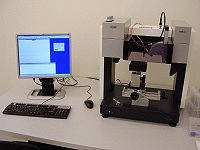Specific Process Knowledge/Characterization/Drop Shape Analyzer: Difference between revisions
Appearance
| Line 5: | Line 5: | ||
== The Drop Shape Analyzer == | == The Drop Shape Analyzer == | ||
[[image:DropShapeAnalyzer.jpg|200x200px|right|thumb|The Krüss DSA 100s Drop Shape Analyzer]] | |||
The Krüss DSA 100S Drop Shape Analyzer will analyze the shape a drop of liquid on a surface, or suspended from a needle, in order to calculate the contact angle, or the surface tension, respectively. It is mostly used to measure the contact angle as a measure of the hydrophobicity/hydrophility of the sample surface. | The Krüss DSA 100S Drop Shape Analyzer will analyze the shape a drop of liquid on a surface, or suspended from a needle, in order to calculate the contact angle, or the surface tension, respectively. It is mostly used to measure the contact angle as a measure of the hydrophobicity/hydrophility of the sample surface. | ||
'''The user manual, user APV(s), technical information, and contact information can be found in LabManager:''' | '''The user manual, user APV(s), technical information, and contact information can be found in LabManager:''' | ||
Revision as of 14:12, 10 January 2014
Feedback to this page: click here
THIS PAGE IS UNDER CONSTRUCTION
The Drop Shape Analyzer

The Krüss DSA 100S Drop Shape Analyzer will analyze the shape a drop of liquid on a surface, or suspended from a needle, in order to calculate the contact angle, or the surface tension, respectively. It is mostly used to measure the contact angle as a measure of the hydrophobicity/hydrophility of the sample surface.
The user manual, user APV(s), technical information, and contact information can be found in LabManager:
Drop Shape Analyzer in LabManager
An overview of the performance of the Drop Shape Analyzer
| Purpose | Imaging and analysis of of the shape of the interface between liquid and air |
|
|---|---|---|
| Performance | Measurement accuracy |
|
| Process parameters | Available liquids |
|
| Sample requirements | Substrate material allowed |
|
| Substrate size |
| |
| Batch size |
|
